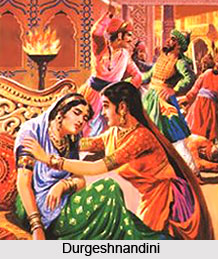 Durgeshnandini is one of the classic literary works of the Indian writer Bankim Chandra Chatterjee. It is a Bengali romantic novel written with a historical backdrop. The novel portrays the lives of Tilottama, the daughter of a Bengali feudal lord, a Mughal General named Jagat Singh and Ayesha, the daughter of a rebel Pathan leader who had a conflict with Jagat Singh. The tale has been woven in the period of Mughal Emperor Akbar during the Pathan-Mughal conflicts that occurred in south-western region of the present day West Bengal. Bankim Chandra stepped into the arena of Bengali novels with Durgeshnandini in the year 1865. In the history of Bengali literature, the novel also established itself as the first major Bengali novel. Certain local legends in the Mandaran region of Hooghly district served as inspiration for the novel, which were collected by the great uncle of Bankim Chandra. Although Durgeshnandini encountered harsh criticism owing to its lucid language by the conservative critics, it earned great appreciations and accolades from the contemporary scholars.
Durgeshnandini is one of the classic literary works of the Indian writer Bankim Chandra Chatterjee. It is a Bengali romantic novel written with a historical backdrop. The novel portrays the lives of Tilottama, the daughter of a Bengali feudal lord, a Mughal General named Jagat Singh and Ayesha, the daughter of a rebel Pathan leader who had a conflict with Jagat Singh. The tale has been woven in the period of Mughal Emperor Akbar during the Pathan-Mughal conflicts that occurred in south-western region of the present day West Bengal. Bankim Chandra stepped into the arena of Bengali novels with Durgeshnandini in the year 1865. In the history of Bengali literature, the novel also established itself as the first major Bengali novel. Certain local legends in the Mandaran region of Hooghly district served as inspiration for the novel, which were collected by the great uncle of Bankim Chandra. Although Durgeshnandini encountered harsh criticism owing to its lucid language by the conservative critics, it earned great appreciations and accolades from the contemporary scholars.
Synopsis of Durgeshnandini
Set in the time of Pathan-Mughal conflicts, Durgeshnandini narrates a tale of love. The General of Mughal army, Jagat Singh, along with the son of Raja Man Singh had an encounter with Tilottama. Tilottama was the daughter of a feudal lord of Mandaran in south-western Bengal, Birendra Singha. The course of events traps Jagat Singh and Tilottama in an ardent feeling of love for each other. When the couple was busy in the preparations of their wedding ceremony, a rebel Pathan leader named Katlu Khan attacked Mandaran which led to a fierce battle. In the battle, Birendra Singha was killed and Jagat Singh was confined in the prison along with Bimala, the widow of Birendra Singha, and his daughter Tilottama. Ayesha, the daughter of Katlu Khan, saved Tilottama from being the victim of her father`s lust but in the events that followed Ayesha found herself in love with Jagat Singh. Bimala later stabbed Katlu Khan for avenging the death of her husband. Meanwhile, Jagat Singh was set free owing to a pact signed by Man Singh with the Pathans. Jagat Singh also emerged as a victor in the duel challenged by the lover of Ayesha named Osman. Later, the realization struck Ayesha hard that being a Hindu prince; Jagat Singh would never marry Ayesha, who was a Muslim woman. Eventually, Ayesha abandoned all of her hopes and helped Tilottama to marry her love, Jagat Singh.
 Inspiration of Durgeshnandini
Inspiration of Durgeshnandini
Purna Chandra Chatterjee, the younger brother of Bankim Chandra had consolidated the fact that the story was inspired from a popular legend of Mandaran. The legend says that when the fort of the local feudal lord was attacked by the Pathans and his wife and daughter were taken to the prison of Orissa, Jagat Singh arrived to rescue them. However, Jagat Singh was also imprisoned along with them. The story appealed Bankim Chandra profoundly at the young age of 19 and after a few years it was visaged as a classic novel by the author.
Contemporary critics offered a mixed response to the novel. On one hand Durgeshnandini was highly appreciated by the Sanskrit scholars of Bhatpara while on the other it did not get much acclamation from the scholars of Calcutta. The editor of Somprakash, Dwarakanath Vidyabhushan, had greatly criticised the unconventional writing style of Bankim Chandra. However, it received praises from Sambad Prabhakar and many other contemporary newspapers. In the entire lifetime of Bankim Chandra, 13 editions of Durgeshnandini had been published out of which the last one was in 1893. The novel was also translated into different languages viz. Hindustani (1876), English (1882), Hindi (1882) and Kannada (1885). The stage adaptation of it was done in the year 1873.



















